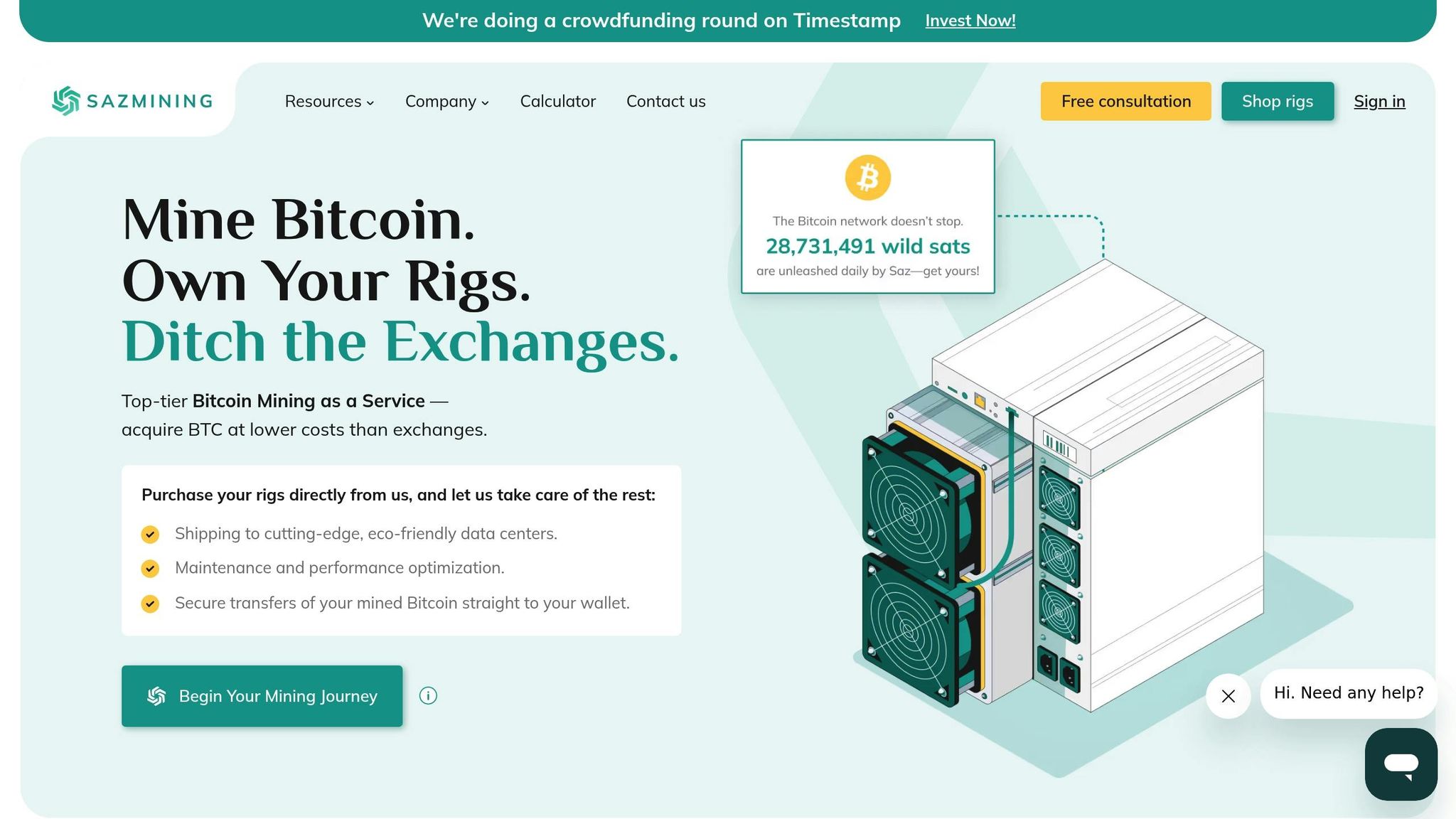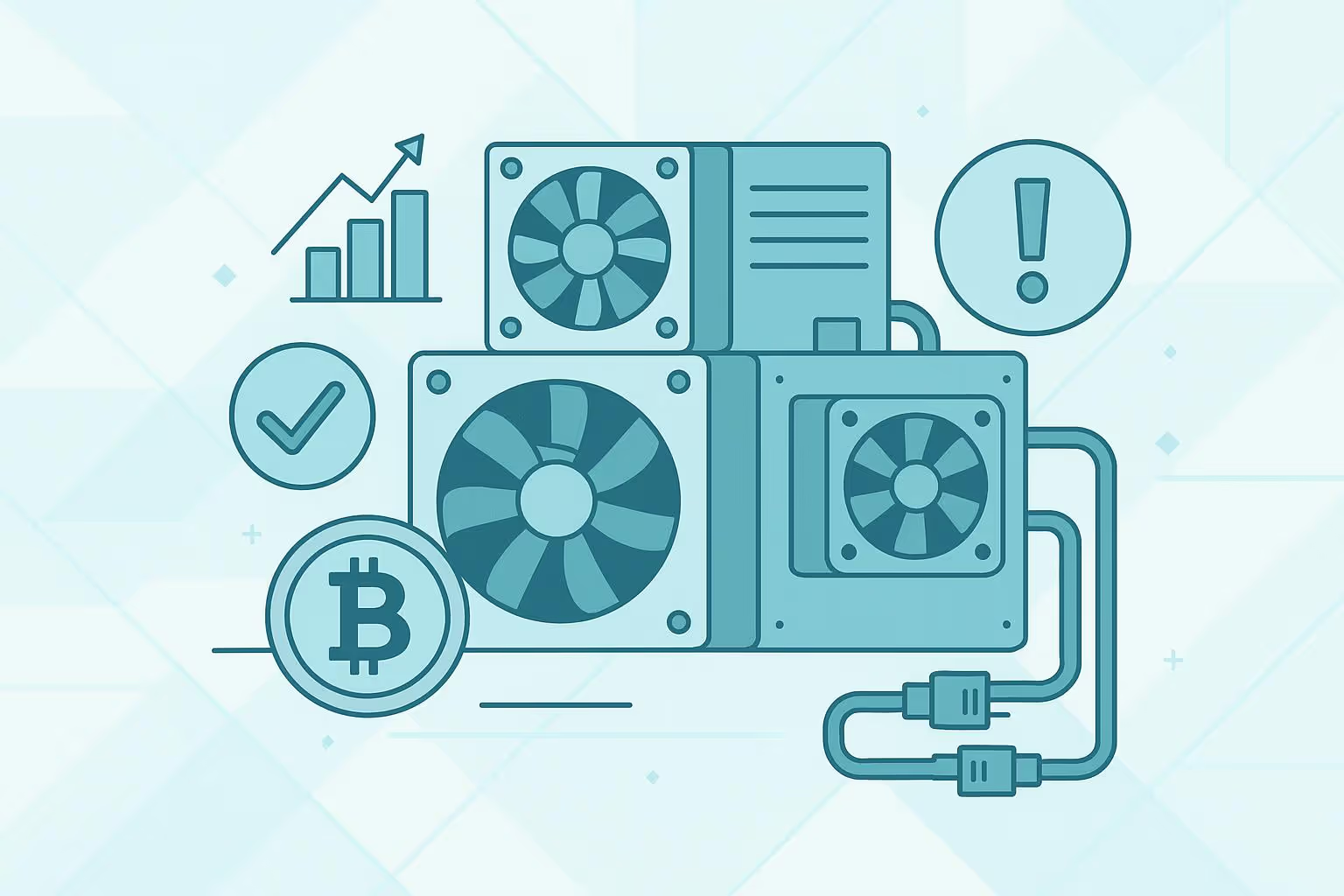Bitcoin mining can be challenging, with issues like hardware breakdowns, high energy costs, overheating, and network disruptions impacting profitability. Here's a quick rundown of the main problems and how to address them:
- Hardware Failures: Cooling fans, hashboards, and power supplies often fail. Regular maintenance, cleaning, and timely replacements are key.
- Energy Inefficiency: Older equipment and poor power management drive up costs. Use energy-efficient hardware and consider renewable power sources.
- Overheating: Rising temperatures damage equipment. Improve airflow, clean dust, and explore advanced cooling methods like liquid or immersion cooling.
- Network Problems: Unstable connections and misconfigurations can halt mining. Use wired connections, backup pools, and updated software.
This Problem Might Make Mining Impossible Soon | Home Crypto Mining Shed
Fixing Hardware Failures
Hardware failures can bring mining operations to a standstill. Identifying and addressing issues early is key to minimizing expensive downtime.
Common Hardware Problems
One of the most frequent issues miners face is cooling fan failures. If fans stop working or slow down, your equipment can overheat in minutes. Warning signs include unusual grinding noises or complete silence, which often indicate a malfunctioning fan.
Another major issue is faulty hashboards. These circuit boards handle mining computations, and when they fail, your hash rate can plummet. Look out for error messages in the miner’s interface, unusual temperature readings, or a complete loss of hashing power from specific boards. Some newer ASIC models complicate repairs with aluminum-plated components that are less resistant to heat cycling.
Power supply unit (PSU) problems are another common culprit. These issues range from complete failures to inconsistent power delivery. Symptoms include random restarts, fluctuating hash rates, or the miner failing to power on. Unstable power not only damages the PSU but can also lead to failures in other hardware components.
Lastly, dust accumulation poses a subtle but serious threat. Dust can clog fans, block heat sinks, and even cause short circuits in setups without proper air filtration.
Addressing these problems quickly with the right repair methods can keep your mining operation running smoothly.
Repair and Maintenance Steps
Start by gathering detailed information from your miner’s kernel log. This log tracks vital stats like hash rate, power consumption, fan speeds, and error messages. Check both the current log for active problems and the historical log to identify patterns.
Cooling system issues often require a straightforward approach. Begin with a visual and audio inspection. Use compressed air or a soft brush to remove dust from fans and heat sinks. If fans are noisy or spinning slower than usual, replacing them is usually more cost-effective than repairing. Make sure the miner has enough space for proper airflow and that exhaust vents are clear.
For hashboard problems, the kernel log can reveal temperature-related errors like "Over Temperature" or "ERROR TEMP TOO HIGH". These messages often indicate cooling issues rather than actual board failure. If specific hashboards underperform or show errors consistently, try reseating their connections. Persistent issues may require replacing the hashboard, a task best handled with proper technical expertise and ESD protection.
When dealing with power supply issues, start by inspecting all cable connections. Unplug and reconnect each cable, checking for wear, burn marks, or loose connections. Use a multimeter to ensure your power source delivers stable voltage. In most cases, replacing a failing PSU is more practical than attempting internal repairs.
Cable and connection problems are often quick to fix. Check all cables for damage, ensure connections are tight, and replace any worn or damaged ones. Loose connections can cause intermittent failures, so make sure every connection is secure.
Preventative care is just as important as repairs. Set up a regular maintenance routine that includes cleaning, monitoring key metrics like hash rate and temperature, and documenting any unusual behavior. These steps can help you spot potential issues before they become serious.
The lifespan of mining hardware depends heavily on how well it’s maintained. A 2021 study found Bitcoin mining devices lasted only 1.3 years before becoming unprofitable. However, a 2024 review suggested that with proper upkeep, mining equipment can remain effective for 4–5 years [32]. Regular maintenance and timely repairs can significantly extend the life of your hardware, often determining whether your operation stays profitable or faces premature equipment replacement.
Reducing Energy Waste in Mining
Bitcoin mining is notorious for its high energy demands, with power costs and environmental concerns posing challenges to its long-term viability.
What Drives High Energy Consumption
Several factors contribute to the substantial energy use in mining. Outdated hardware and poorly designed facilities often operate inefficiently, consuming more power than necessary. Additionally, heavy reliance on fossil fuels exacerbates energy waste. Tackling these inefficiencies is essential to enhance both the profitability and the environmental footprint of mining operations.
Smarter Ways to Save Energy
Adopting modern, energy-efficient hardware and improving cooling systems - through better airflow and temperature control - can significantly cut energy use. These upgrades not only reduce costs but also help mining operations run more efficiently.
Switching to renewable energy sources, such as solar, wind, or hydropower, offers a cleaner and more cost-effective solution in the long run. While initial setup costs may be high, the savings on electricity can be substantial over time. Bitcoin mining's ability to adjust energy consumption based on grid demand also supports grid stability, making it easier to integrate renewables into operations.
These energy-saving approaches reflect the efforts of companies like Sazmining, which runs entirely on renewable energy. By aligning sustainability with profitability, Sazmining showcases how mining can reduce its environmental impact without compromising financial success.
Preventing Overheating and Improving Cooling
Excessive heat can wreak havoc on mining rigs, slowing performance, causing breakdowns, and even leading to costly hardware replacements.
Overheating Warning Signs and Potential Damage
There are a few telltale signs that your mining rig might be overheating. These include reduced hash rates, frequent shutdowns triggered by temperature sensors, and unusual fan noise. Ignoring these signs can lead to long-term damage, as prolonged overheating accelerates component wear and tear, often resulting in expensive repairs or early hardware replacement.
High ambient temperatures can also hurt performance. Mining equipment is built to function within specific temperature ranges. When the environment gets too hot, built-in safeguards may kick in, reducing performance or even shutting down the equipment to prevent damage.
The good news? These risks can be managed with smart cooling strategies.
Smarter Cooling Strategies
Once you identify overheating risks, it’s time to take action with effective cooling measures to protect your mining setup.
Start with airflow. Arrange your rigs so that hot air from one machine doesn’t get pulled into another. Create clear paths for cool air to flow in and warm air to exit. A hot aisle/cold aisle layout works particularly well, as it separates intake and exhaust zones, ensuring efficient airflow.
Dust is another enemy of cooling efficiency. Dust buildup restricts airflow and hampers heat dissipation, especially in high-dust environments. Regularly clean filters and use compressed air to keep components dust-free. If dust is a persistent problem, consider installing a positive pressure system to push filtered air into the space, reducing particle accumulation.
Room temperature control is equally important. In warmer regions, air conditioning or other climate-control measures can help keep the ambient temperature within safe limits. When planning your cooling setup, don’t forget to account for the total heat output of your mining hardware.
For localized hot spots or extreme conditions, supplemental cooling equipment can make a big difference. Exhaust fans can efficiently remove hot air, while evaporative coolers are energy-efficient options for dry climates. In dense mining setups, liquid cooling systems are becoming more popular, though they do come with higher upfront costs and maintenance requirements.
Cooling needs can also vary depending on location. For instance, desert regions might benefit from evaporative cooling during dry seasons, while humid areas may require dehumidification alongside traditional cooling methods. In colder regions, free air cooling during winter months can significantly cut energy costs by using naturally cool outdoor air.
For those looking to take cooling to the next level, immersion cooling is an advanced option. This method involves submerging mining hardware in specially designed dielectric fluids that efficiently draw heat away from components. While it requires a larger initial investment and expertise, immersion cooling can deliver substantial energy savings in the long run.
sbb-itb-c71a7d0
Fixing Network and Connection Problems
Network disruptions can grind mining operations to a halt, turning your once-profitable rigs into costly, idle machines. Even brief interruptions can lead to lost rewards and reduced earnings.
Frequent Network Issues
One of the most common issues miners face is unstable internet connections. Even a few seconds of downtime can cause your mining rig to lose communication with the mining pool, cutting off your contribution to the collective hash power. During these interruptions, you’re not earning, plain and simple.
Another headache comes from mining pool configuration errors. Mistyped addresses, incorrect ports, or outdated login credentials can prevent your rig from connecting properly. This is especially frustrating because everything may appear to be running fine, but without payouts, it’s clear something is wrong.
Firewall and router restrictions are also frequent culprits. Many modern routers come with built-in security settings that block the specific ports mining software needs to communicate with pools. If these ports are blocked, your mining traffic can’t get through.
Lastly, DNS resolution problems can disrupt operations. Even if your internet works fine for browsing or streaming, your mining rig may fail to connect to a pool if it can’t resolve the pool’s domain name. This issue often arises when pools update their server infrastructure or when local DNS servers encounter problems.
Addressing these issues is essential before focusing on long-term connection reliability.
Connection Reliability Fixes
To keep your mining rigs running smoothly, you’ll need to tackle these network challenges head-on. Here’s how:
- Switch to wired connections. While Wi-Fi is convenient, Ethernet cables offer far more stability, lower latency, and fewer interruptions. A wired connection avoids interference from other wireless devices and ensures consistent bandwidth - critical for mining.
- Inspect and replace network cables. Over time, cables like Cat5e or Cat6 can degrade, especially in dusty mining environments. Damaged cables often cause intermittent issues that are hard to diagnose. If you spot visible wear or are experiencing frequent disconnections, it’s time for an upgrade.
- Restart networking equipment in sequence. When issues arise, power cycle your modem first, wait two minutes, then reboot your router, followed by your mining rigs. This ensures each device connects properly to the next.
- Set up backup mining pools. Most mining software allows you to list multiple pool addresses. If your primary pool goes down, your rig will automatically switch to a backup, keeping operations uninterrupted. Aim to configure at least two backup pools.
- Keep mining software updated. Outdated software can struggle with newer pool protocols or fail to handle network errors effectively. Check for updates weekly or enable automatic updates if your software supports it.
- Opt for a reliable internet service provider (ISP). Business-grade connections often come with service level agreements (SLAs) that guarantee consistent speeds and faster support. Residential plans, on the other hand, may throttle bandwidth during peak hours, which can hurt mining performance.
- Adjust firewall and router settings. Open the necessary ports for mining traffic, such as 4444, 3333, or 8080. You can also use Quality of Service (QoS) settings to prioritize mining data over other network activities.
- Assign static IP addresses to your rigs. Dynamic IP assignment can lead to conflicts when multiple devices request the same address. A static IP eliminates this issue, ensuring stable connectivity.
- Monitor network performance. Use built-in tools or third-party apps to track stability, latency, and bandwidth usage. By keeping an eye on these metrics, you can spot patterns and address problems before they impact your mining profitability.
Monitoring Tools and Performance Tracking
Keeping a close eye on your mining operation is essential to avoid small hiccups turning into costly setbacks. Just like hardware and cooling, staying proactive in monitoring plays a big role in tackling common Bitcoin mining challenges. Without the right tracking systems in place, seemingly minor issues can escalate, potentially eating into your profits. Effective monitoring ties seamlessly with the other strategies we've discussed, helping you catch and resolve problems before they grow.
Performance Monitoring Software
Using the right software makes managing your rigs much easier. These tools provide real-time tracking and automated alerts, ensuring your mining setup runs as efficiently as possible.
Sazmining's Customer Dashboard

Sazmining offers a customer dashboard that acts as a one-stop hub for monitoring your mining operations. It provides real-time data for each rig, including hash rates, energy usage, and Bitcoin earnings. Each machine is assigned a unique serial number, making it simple to pinpoint which rigs are performing well and which may need attention.
The dashboard also includes maintenance alerts. If a rig's performance dips below the expected level, it automatically switches to a "Maintenance Mode" status. This feature prompts quick action, helping you prevent unnecessary losses in earnings.
Beyond performance tracking, the dashboard streamlines other tasks. You can pay monthly service fees, link your Bitcoin wallet, and even expand your mining capacity - all from one integrated platform. Plus, real-time notifications keep you updated on essential information like maintenance schedules and critical updates.
Here’s what one user had to say about the dashboard:
"The user portal is intuitive, clearly showing the machines I own, average hash rates, and payouts." - Matthew S, Sazmining Customer
Conclusion: Better Bitcoin Mining Results
Navigating the challenges of Bitcoin mining requires a focus on three key strategies: regular maintenance, energy efficiency, and effective monitoring. Together, these approaches help ensure your mining operation remains competitive and profitable in an ever-changing market. Each piece of the puzzle plays a role in protecting and enhancing your overall investment.
Take hardware maintenance, for example. From cleaning fans to replacing worn-out parts, these simple actions can significantly boost device performance while reducing noise and preventing costly breakdowns. Ignoring small issues could lead to major repairs or extended downtime - and every hour your rigs are offline eats into your profits.
Energy management has become even more crucial as Bitcoin rewards shrink due to halving events. Miners must find smarter ways to cut electricity costs while maintaining efficiency. Modern cooling systems not only improve heat dissipation but also extend the lifespan of your hardware. These upgrades directly reduce operational expenses, giving you a better chance to stay ahead in the game.
Switching to renewable energy is another powerful way to lower costs while minimizing environmental impact. However, juggling maintenance schedules, energy optimization, and other technical details can be overwhelming for many miners.
That’s where managed mining services like Sazmining step in. They handle the heavy lifting with renewable energy-powered data centers, transparent pricing (no hidden fees), and a detailed performance dashboard. With a 90% annual rig performance guarantee, Sazmining allows you to enjoy professional-grade mining management while freeing up your time to focus on other priorities.
FAQs
What are the best ways to maintain my Bitcoin mining hardware and extend its lifespan?
To ensure your Bitcoin mining hardware stays in top shape and lasts longer, regular upkeep is a must. Start by cleaning your equipment often to prevent dust from clogging airflow, which can lead to overheating. Use tools like an anti-static brush or compressed air to carefully clean components, especially if you’re working in a dusty environment.
Check that your cooling system is functioning properly by examining fans and heat sinks for dust or damage. If overheating persists, you might want to upgrade to a liquid cooling system for better temperature control. Keep your mining space at an ideal temperature - between 50–77°F - and maintain low humidity levels to reduce the risk of corrosion.
Lastly, inspect your hardware routinely for wear and tear, such as frayed cables, loose connections, or odd noises. Make sure to update firmware and mining software as recommended by the manufacturer to optimize performance and security. It’s also smart to keep spare parts like fans and power supplies nearby, so you can quickly address any unexpected issues and minimize downtime.
What are the best ways to lower energy costs in Bitcoin mining?
Reducing energy costs in Bitcoin mining not only improves profitability but also supports a more sustainable operation. One smart move is to tap into renewable energy sources like solar or wind power. These can offer a consistent flow of low-cost electricity and lessen dependence on traditional power grids.
Another key tactic is upgrading to energy-efficient mining hardware. Modern mining rigs are designed to deliver high performance while using less power, which can make a noticeable difference in electricity bills. Additionally, situating your mining facility near affordable or surplus energy sources, such as hydroelectric plants or natural gas sites, can further trim expenses.
By implementing these approaches, miners can manage costs effectively while maintaining productivity and supporting cleaner energy solutions.
How can I maintain a stable network connection to avoid disruptions in my Bitcoin mining operations?
To keep your Bitcoin mining operations running smoothly, a stable network connection is crucial. Start by selecting a dependable internet service provider that offers consistent uptime. For better stability and speed, opt for a wired Ethernet connection instead of relying on Wi-Fi.
Make it a habit to check your router, network cables, and hardware components like network interface cards to ensure everything is in good working order. If you notice frequent disruptions, upgrading your router or setting up a backup internet connection can help reduce downtime. Regular updates and proper configuration of your network equipment can also significantly improve reliability, keeping your mining activities uninterrupted.

